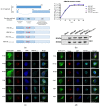Influenza A Virus Infection Activates NLRP3 Inflammasome through Trans-Golgi Network Dispersion
- PMID: 35062292
- PMCID: PMC8778788
- DOI: 10.3390/v14010088
Influenza A Virus Infection Activates NLRP3 Inflammasome through Trans-Golgi Network Dispersion
Abstract
The NLRP3 inflammasome consists of NLRP3, ASC, and pro-caspase-1 and is an important arm of the innate immune response against influenza A virus (IAV) infection. Upon infection, the inflammasome is activated, resulting in the production of IL-1β and IL-18, which recruits other immune cells to the site of infection. It has been suggested that in the presence of stress molecules such as nigericin, the trans-Golgi network (TGN) disperses into small puncta-like structures where NLRP3 is recruited and activated. Here, we investigated whether IAV infection could lead to TGN dispersion, whether dispersed TGN (dTGN) is responsible for NLRP3 inflammasome activation, and which viral protein is involved in this process. We showed that the IAV causes dTGN formation, which serves as one of the mechanisms of NLRP3 inflammasome activation in response to IAV infection. Furthermore, we generated a series of mutant IAVs that carry mutations in the M2 protein. We demonstrated the M2 proton channel activity, specifically His37 and Trp41 are pivotal for the dispersion of TGN, NLRP3 conformational change, and IL-1β induction. The results revealed a novel mechanism behind the activation and regulation of the NLRP3 inflammasome in IAV infection.
Keywords: M2 ion channel protein; NLRP3 inflammasome; influenza A virus; trans-Golgi network.
Conflict of interest statement
The authors declare no conflict of interest. The funders had no role in the design of the study; in the collection, analyses, or interpretation of data; in the writing of the manuscript, or in the decision to publish the results.
Figures












Similar articles
-
Targeting Inflammasome Activation in Viral Infection: A Therapeutic Solution?Viruses. 2023 Jun 27;15(7):1451. doi: 10.3390/v15071451. Viruses. 2023. PMID: 37515138 Free PMC article. Review.
-
NS1 Protein of 2009 Pandemic Influenza A Virus Inhibits Porcine NLRP3 Inflammasome-Mediated Interleukin-1 Beta Production by Suppressing ASC Ubiquitination.J Virol. 2018 Mar 28;92(8):e00022-18. doi: 10.1128/JVI.00022-18. Print 2018 Apr 15. J Virol. 2018. PMID: 29386291 Free PMC article.
-
Dengue Virus Serotype 2 and Its Non-Structural Proteins 2A and 2B Activate NLRP3 Inflammasome.Front Immunol. 2020 Mar 10;11:352. doi: 10.3389/fimmu.2020.00352. eCollection 2020. Front Immunol. 2020. PMID: 32210961 Free PMC article.
-
PtdIns4P on dispersed trans-Golgi network mediates NLRP3 inflammasome activation.Nature. 2018 Dec;564(7734):71-76. doi: 10.1038/s41586-018-0761-3. Epub 2018 Nov 28. Nature. 2018. PMID: 30487600 Free PMC article.
-
The role of the NLRP3 inflammasome in regulation of antiviral responses to influenza A virus infection.Antiviral Res. 2017 Dec;148:32-42. doi: 10.1016/j.antiviral.2017.10.020. Epub 2017 Oct 31. Antiviral Res. 2017. PMID: 29097227 Review.
Cited by
-
Inflammasome activation by viral infection: mechanisms of activation and regulation.Front Microbiol. 2023 Aug 7;14:1247377. doi: 10.3389/fmicb.2023.1247377. eCollection 2023. Front Microbiol. 2023. PMID: 37608944 Free PMC article. Review.
-
Targeting Inflammasome Activation in Viral Infection: A Therapeutic Solution?Viruses. 2023 Jun 27;15(7):1451. doi: 10.3390/v15071451. Viruses. 2023. PMID: 37515138 Free PMC article. Review.
-
Golgi Stress Response: New Insights into the Pathogenesis and Therapeutic Targets of Human Diseases.Mol Cells. 2023 Apr 30;46(4):191-199. doi: 10.14348/molcells.2023.2152. Epub 2022 Dec 28. Mol Cells. 2023. PMID: 36574967 Free PMC article. Review.
-
Host Innate Antiviral Response to Influenza A Virus Infection: From Viral Sensing to Antagonism and Escape.Pathogens. 2024 Jul 3;13(7):561. doi: 10.3390/pathogens13070561. Pathogens. 2024. PMID: 39057788 Free PMC article. Review.
-
Diacerein reduces inflammasome activation and SARS-CoV-2 virus replication: a proof-of-concept translational study.Front Pharmacol. 2024 Oct 7;15:1402032. doi: 10.3389/fphar.2024.1402032. eCollection 2024. Front Pharmacol. 2024. PMID: 39434905 Free PMC article.
References
Publication types
MeSH terms
Substances
LinkOut - more resources
Full Text Sources
Molecular Biology Databases
Miscellaneous

